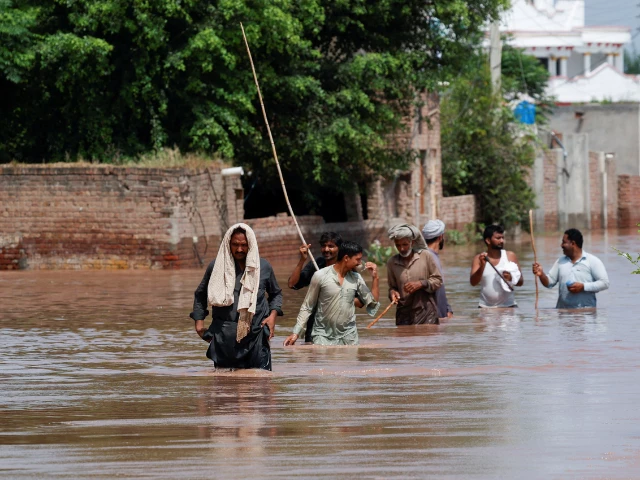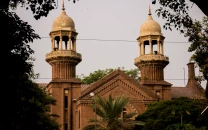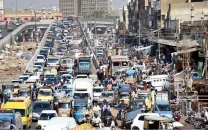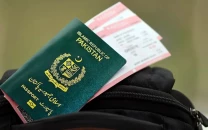Over 100 dead as Punjab reels from devastating floods
More than 4,700 villages and 4.57 million people have been affected across the province

At least 101 people have died in Punjab due to widespread flooding, officials said, as more than 4,700 villages and around 4.57 million residents have been affected across the province.
Relief Commissioner Nabeel Javed of the Punjab Provincial Disaster Management Authority (PDMA) said on Saturday that about 2.51 million people had been relocated to safer areas.
According to a PDMA report on flood damages, the Chenab River inundated 2,489 villages, while the Sutlej and Ravi rivers affected 701 and 1,458 villages respectively.
In Rajanpur, Deputy Commissioner Shafqatullah Mushtaq confirmed that the Head Panjnad flood surge had merged into the Indus River at Kot Mithan, where high-level flooding continues. Floodwaters entered the Kacha (riverine belt) areas, prompting the evacuation of remaining residents. Authorities have been making public announcements urging people to move immediately to relief camps.
In Jalalpur Pirwala, water levels have started to recede at the breaching point, but the Motorway Interchange remains closed. Many residents have taken shelter near the motorway on a self-help basis. The breach in the Uch Sharif Highway submerged more than 10 villages, displacing thousands, while water levels have also begun to fall at the Jalalpur public embankment.
At Head Muhammad Wala, water levels of the Chenab continued to decline, easing pressure on the Shershah Bridge. Near Tehsil Alipur, the inflow and outflow at Head Panjnad was recorded at 575,195 cusecs. More than 100 villages were inundated, including Marhi Shahr, Choki Gabol, Seetpur, Khairpur Sadat, Khangarh Doema, and Sultanpur, though Alipur city was spared.
Senior Minister Marriyum Aurangzeb and Federal Parliamentary Secretary Amir Talal Gopang visited affected areas and directed authorities to accelerate evacuation efforts. Punjab Chief Minister Maryam Nawaz Sharif is expected to visit on Monday.
In Vehari, flood levels in the Sutlej have fallen, but large-scale relief operations remain urgently needed. In Muzaffargarh, the Chenab’s level at Shershah Bridge has remained steady for days at 392.70 ft, just below the 395 ft high flood gauge. Low-lying areas remain under 6–8 feet of water.
Authorities reported outbreaks of epidemic diseases, including stomach infections and skin rashes. In Bahawalpur, floodwaters engulfed Fatu Wali Goth and Ghani Samma Sutha Road, leaving hundreds stranded. Families with children and livestock have been forced into relief camps after entire settlements were washed away by the Sutlej flood surge.
Extremely high-level flood passing through Panjnad
The PDMA reported that an extremely high-level flood was passing through Panjnad with a discharge of 575,000 cusecs. At Head Muhammad Wala, the water level stood at 410.5 ft against the high flood mark of 417.5 ft, while at Shershah Bridge the flow was 392.7 ft against the danger level of 393.5 ft. The PDMA said water levels at both points are expected to fall significantly within 48 hours.
On the Ravi, a medium-level flood of 57,000 cusecs was recorded at Head Sadhnai, while the Sutlej experienced low-level flooding with 83,000 cusecs at Ganda Singh Wala and 87,000 cusecs at Sulemanki.
The PDMA also highlighted reservoir levels, noting that Mangla Dam is 93% full and Tarbela Dam has reached capacity, while India’s Bhakra, Pong, and Thein dams were at 88%, 94%, and 89% capacity respectively.
Normal flows were reported at Marala, Qadirabad (61,000 cusecs), Trimmu (108,000 cusecs), Shahdara (31,000 cusecs), and Jassar (12,000 cusecs), as well as Khanki (68,000 cusecs). Bloaki Headworks registered 48,000 cusecs, with a low-level flood.
The PDMA said river flows across Punjab are gradually returning to normal as rains have stopped in the upper catchment areas.
Tarbela Dam’s water level stood at 1,550.00 ft, holding 5.728 million acre-feet, while Mangla recorded 1,235.95 ft with 6.8 million acre-feet. Chashma Reservoir contained 0.311 million acre-feet. Collectively, the three reservoirs held 12.839 million acre-feet of usable water.
The Federal Flood Commission reported extreme flooding at Guddu on the Indus, medium-level at Sukkur Barrage, and very high-level at Panjnad Barrage on the Chenab. Very high-level flooding is predicted at Guddu within the next 24–48 hours, while Sukkur is expected to reach high flood levels.
Rescue and relief operations
The South Punjab government has deployed airlift drones to deliver food and medicine to flood victims in inaccessible areas. Officials described the effort as Pakistan’s first emergency airlift drone service, capable of carrying up to 200 kilograms of aid and evacuating people from dangerous locations. Ten more drones will be procured to expand operations.
The Punjab Saaf Pani Authority has so far provided 1.57 million litres of clean drinking water to more than 525,000 people across the province. Yesterday alone, 192,700 litres were supplied.
So far, 392 relief camps, 493 medical camps, and 422 veterinary camps have been established in the hardest-hit districts. Police said over 16,000 personnel, supported by 770 vehicles and 40 boats, have rescued more than 681,000 people and moved 2.019 million livestock to safety.
Inspector General of Punjab Police Dr Usman Anwar said Safe City’s thermal imaging and drone cameras were being used in the operations. Rescue 1122 teams, supported by welfare organisations and philanthropists, continued relocating victims and distributing food, water, and other essentials.
The Pakistan Army is also assisting with evacuations. However, residents reported severe difficulties moving belongings and livestock. The body of a man identified as Akhtar, who drowned while attempting to move animals to safety, was recovered in Uch Sharif.



















COMMENTS
Comments are moderated and generally will be posted if they are on-topic and not abusive.
For more information, please see our Comments FAQ